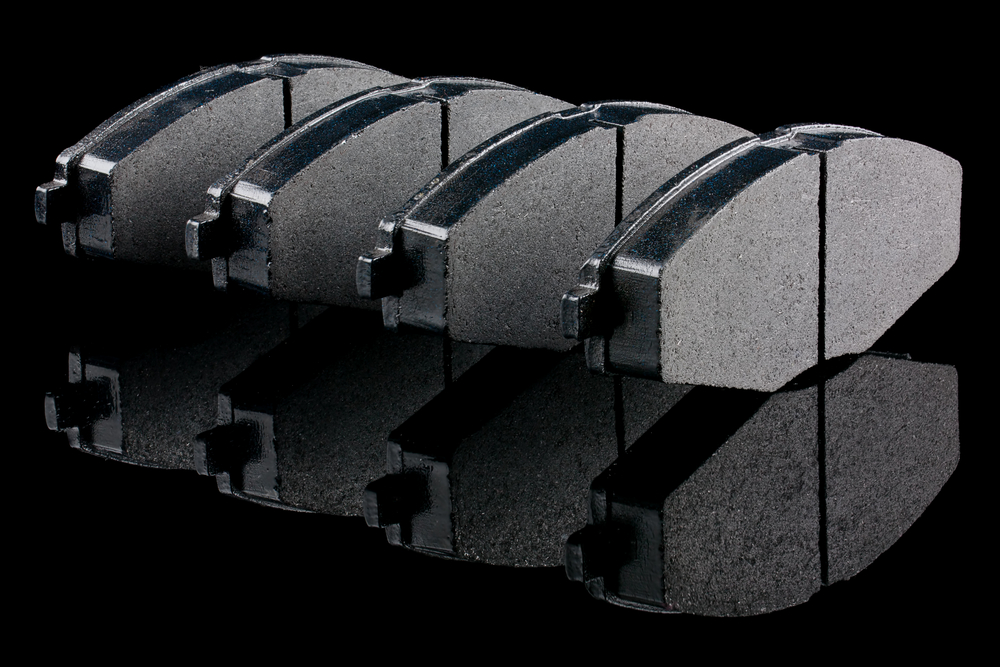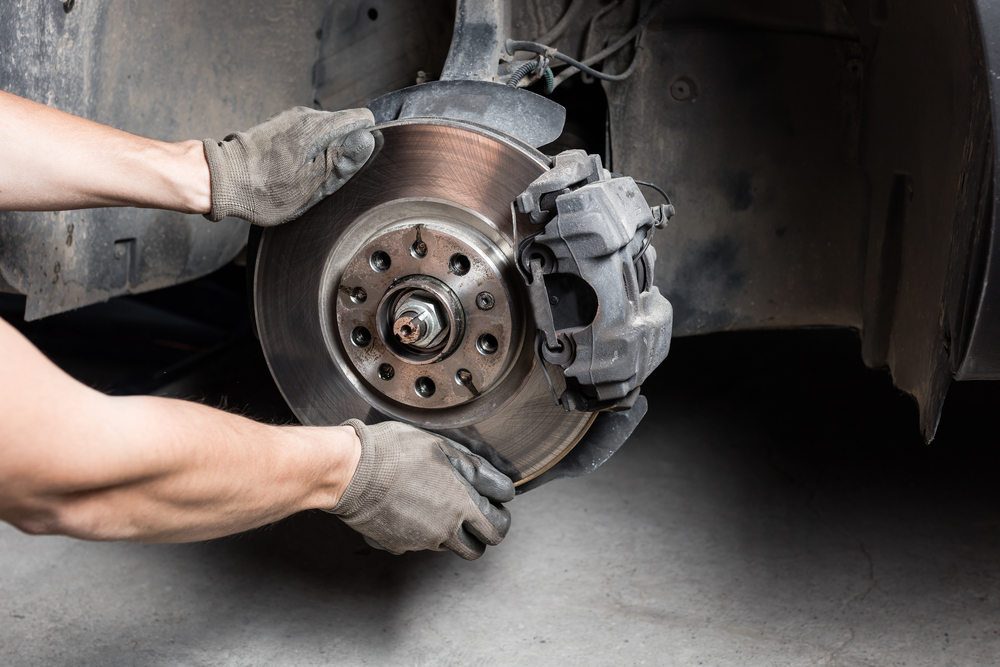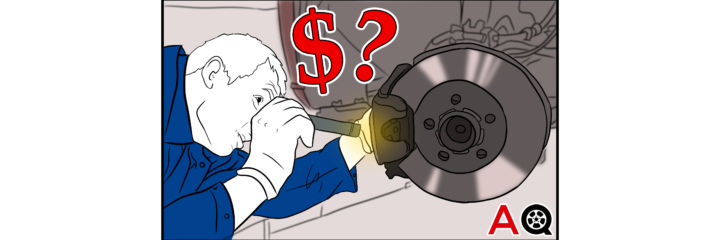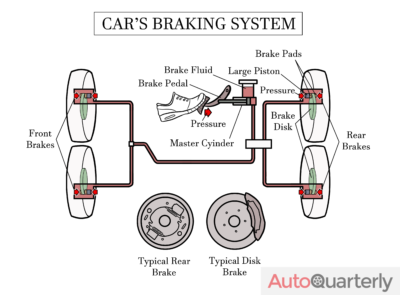Replacing the brake pads in your vehicle can be somewhat of an overwhelming task. The brake pads are one of the most important parts of the braking system and essential in slowing down and stopping your vehicle, so it is natural to want to ensure you are getting the best cost and material quality when you replace them.
In this article, we will discuss the average costs of replacing your brake pads, how to choose new brake pads, and the most common signs that your brake pads are due for a replacement. Read on to find out everything you need to know.
An Overview of Your Car’s Braking System
The braking system in your car is composed of many important elements that work together to stop your vehicle as fast as possible when you press down on the brake pedal. These parts include the brake rotor, brake caliper, master cylinder, ABS pump (if you have an anti-lock brake system), brake lines, and brake fluid. A full diagram of these parts can be found here.
When you press down on the brake pedal, the master cylinder converts the force you exert into hydraulic force. The force you exert is multiplied by a factor of 36, so if you hit the brake with the force of 10 pounds, this is amplified into 360 pounds of force.
Once this force has been amplified, it sends brake fluid through the brake lines to the braking system at your wheel. This fluid presses down small pistons in the brake calipers, which pushes the brake pads down onto the brake rotors, creating friction and heat that slows down the car.
Brake pads and the accompanying brake system parts are present on all four wheels of your car, though you should know that the brakes on your front wheels play a more important part in stopping the car than the ones of the rear wheels. This is because as the car stops, the weight is thrown forward to the front of the car.
The Importance of Brake Pads
Brake pads are incredibly important in the stopping of your car, because, as we discussed above, they are the element of the braking system that applies friction and heat to the brake rotor and stops your vehicle’s movement. If your brake pads are worn down, you will begin to lose the functioning of your brakes, ultimately leading to you not being able to brake and stop your car.
Signs You Need to Replace Your Brake Pads
Any of these signs could indicate that it is time to replace your brake pads sooner rather than later.
Longer Stopping Distance
Experiencing longer stopping distance when engaging your brakes can be frightening and a key sign that you need to replace your brake pads. This longer than usual stopping distance is usually the result of completely thin and worn brake pads that are no longer working, or sometimes a problem with the brake fluid in your car. This sign is especially dangerous because you are at a higher risk for an accident if you cannot stop your car in time.
Brake Pads Look Thin
An easy way to determine if your brake pads are due for a replacement is to examine them yourself. Look between the spokes of your wheel and find the brake caliper. You should be able to see the brake pads inside of this area. The pads should not be less than 1/4 of an inch in thickness; if they are, it is time to get some new ones. If you need help understanding how to find and examine your brake pads, this video can help you out.
Squeaking Sounds
When you press down on your brakes, you shouldn’t be able to hear anything. If you hear a squeaking or other high-pitched sound when you use the brakes, it is a good indicator that your brake pads are worn down. This squeaking sound is a result of the brake caliper grinding against the rotor, something that can damage the rotors over time. This may cost you more if you don’t address the issue quickly, because your brake rotors will likely also need to be replaced.
Grinding Noises
A grinding noise when you press down on the brake pedal has the same cause as a squeaking noise. If you are able to hear any type of loud grinding sound when you use the brakes, it is likely that the pads are so worn down that the caliper is grinding the rotor.
Warning Lights
If an indicator light appears on your dashboard, it is highly likely that you are due for a brake pad replacement. This light will usually either look like an exclamation point in a circle or the word “brake” surrounded by a circle. It is often the same light that warns you that your parking brake is engaged. If this light is lit up while you’re driving and when your parking brake isn’t in use, you may want to go ahead and inspect your brake pads.
Vibrating Brake Pedal
A vibrating brake pedal occurs when the brake pads are so thin that the brake caliper is wearing down the rotor. This causes uneven wear and results in a vibrating feeling as you use the brakes because the pads run over the rotors. If you are experiencing this, you should be looking into replacing your brake pads as soon as possible.

Brake Pad Replacement Cost
The costs of replacing your brake pads can vary wildly depending on the labor costs of the mechanic you visit, the type of brake pad you purchase as a replacement, and if any other parts of the braking system (like rotors or calipers) need replacing, too.
On average, a mechanic’s labor will range from 40 to 150 dollars an hour. The higher end of this estimate is usually seen at vehicle dealerships, while the lower end is commonly found at local mechanic businesses.
In addition to labor, you will need to pay for parts, which range between 50 and 150 dollars for brake pads alone. Per axle, you are looking at about 90 to 300 dollars in cost for brake pad replacement plus labor.
If your brake pads are very worn and have damaged the rotors, you are looking at around 400 to 700 dollars per axle to replace both, as rotors are quite expensive. A brake caliper replacement alongside a brake pad replacement will run you around 200 to 400 dollars per axle.
Can You Replace Your Brake Pads at Home?
While it may seem complicated to replace brake pads, you can actually replace brake pads at home as long as you have the correct tools. Replacing your brake pads at home can save you money on labor costs and may work out more convenient for you, especially if you are a car DIY enthusiast.
DIY Brake Pad Replacement Cost
The cost of DIY-ing your brake pads is essentially the sum of the parts and any tools you need to purchase to complete this repair. You will not have to pay labor costs because you are the one working on your car.
Typically, the cost for brake pads is 50 to 150 dollars, and you will usually pay anywhere between 200 and 400 dollars for rotors and anywhere between 50 and 100 dollars for brake calipers. Of course, the total cost of DIY replacement depends on what parts need to be repaired.
What You Will Need
To replace your own brake pads at home, you will need:
- Your chosen replacement parts
- Lug wrench
- Jack and jack stands
- C-clamp
- Bungee cord
- Brake fluid
- A wrench
The total cost of the replacement may increase if you have to purchase any of these additional materials.
Basic Replacement Steps
Here is a handy step-by-step process for replacing your vehicle’s brake pads.
- To start this process, you will need to remove the wheel and the slider bolt that holds the brake caliper in place. You can then pivot the caliper up, giving you easy access to the brake pad inside.
- Once you have located the brake pad, slide it out of the caliper.
- You can then replace the retaining clips and slide in the new brake pads, making sure to grease the retaining clips to stop them from squeaking.
- Now that the new brake pad is in place, you can push back the pistons using your C-clamp to make room for the thicker size of the new brake pad. You should be monitoring the brake fluid while you do this to ensure it doesn’t overflow.
- The last step is to reposition the caliper, sliding it down over the new brake pad.
- You can then replace and retighten the slider bolt that holds it in place.
- Once this is done, straighten the wheels and remount the tire.
- You can now repeat this process on the other wheels.
If you are interested in watching a step-by-step process of brake and rotor replacement, you can check out this video, which includes a full visual guide.
Additionally, it is a good idea to test drive your vehicle in a safe place after replacing all the brake pads to ensure that everything is responsive and working smoothly.
Cost Summary
In general, brake pad replacements should cost you between 300 and 1000 dollars depending on the parts that need to be replaced and whether or not you pay a professional to do it. The most common price to pay at a mechanic is around 500 dollars, and higher estimates will often include a replacement of rotors and brake pads on all four wheels.
When visiting a professional, make sure to ask what is included in the price of their replacement, so you know exactly which parts are being replaced and why. Not only does this help you stay informed about your vehicle, but it also helps you avoid any unnecessary expense if the cost estimate includes higher-end materials or items that you know you don’t need.
Choosing New Brake Pads
The most important part of replacing your brake pads is choosing the new ones to replace them with. There are a couple of things you should take into your consideration when choosing brake pads, no matter if a professional is installing them or you are replacing them at home.
Material
The material that your brake pads are made of can range from ceramics to organic or metallic. Organic materials are the most common and cheapest option available, while ceramic brake pads are the priciest but highest performing option.
When selecting a material, make sure that it is compatible with your vehicle. A look in your owner’s manual should give you the answer to this. You can also check out our recommendations for the best brake pads available to get you started on your search.
Price
Another major factor in selecting a brake pad is to ensure the price is not out of your budget. Keep in mind that you shouldn’t need the priciest option of ceramic brake pads most of the time, and if a mechanic is trying to upsell you, you can often discuss the other material options highlighted in this article to find something in your price range.
Additionally, when you get your brake pads replaced, it is a good idea to look at the rotors and determine if they are close to needing a replacement. If you are taking your car to a professional, it can be helpful to have everything replaced at once; this will be a higher up-front cost, but can save you money down the line.

How Often Should You Replace Your Brake Pads?
Brake pads wear down differently depending on your usage and the manufacturer of the brake pads. If you don’t have any of the warning signs we discussed above, it can be hard to tell when exactly your brake pads are due for a replacement.
As a general guideline, it can be helpful to check on your brake pads every time you get an oil change, which should be around 5,000 miles—though this depends on your vehicle type and the manufacturer’s recommendations. With typical usage, your brake pads will need replacing around every 40,000 to 60,000 miles, but, again, this number can vary greatly.
Keep in mind that if you have one of the signs of worn-out brake pads or you look at your brake pads and notice they are less than 1/4 of an inch thick, it is most likely time to replace them.
Factors That Wear Down Brake Pads
There are several factors that can wear down on your brake pads. Once you understand what they are, you will be able to take steps to prevent any excessive wear and extend their life.
Environment
The environment you drive in has more effect on your brakes than you might think. Lots of hills and slopes will require you to use your brakes more often than if you lived somewhere flat. If you live in a city and are constantly braking in traffic, that can also wear down your brake pads faster.
It may also help to consolidate your driving trips by combining shorter trips into one longer one. This is both more efficient and can create less wear on your brake pads.
Speed
If you tend to drive on the faster side, the odds are that you also step on your brakes with more force. Constantly putting sudden, large amounts of pressure on your brakes can cause wear to the pads much faster than if you brake slow and steady.
Additionally, you should avoid resting your foot on the brake or keeping a constant amount of pressure on it while driving. Doing this will keep your brakes engaged the entire time you are driving and cause unnecessary wear; it is a much better option to have your foot hovering above the brake instead of resting on it.
Weight
Carrying heavy loads on a regular basis will put more strain on your brakes. This is because you will need more braking force to stop your car from moving when it is heavier. If you want to prolong the life of your brakes, it might be a better idea to avoid carrying heavy cargo or loads in your car as much as possible.
New Brake Pads for Safe Driving
Replacing your brake pads may not be the cheapest repair to undertake, but it is an essential one. Without functioning brake pads, your ability to slow down and stop your car is greatly impaired, leaving you at risk of an accident.
Whether you choose to take your car to a professional to get the brake pads replaced or opt to DIY at home, brake pad replacement is an important maintenance step in upkeeping your car and ensuring you get to your destination safely.



